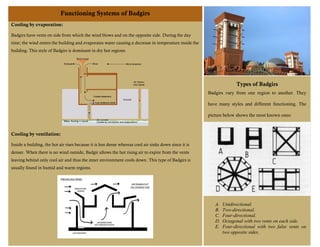Types of Traditional Persian Wind Towers (Badgirs) Explained
•
1 like•378 views
The document describes different types of badgirs, traditional wind towers used in Persian architecture for natural cooling and ventilation. It identifies five common styles of badgirs that vary based on the number and placement of vents, including unidirectional, two-directional, four-directional, and octagonal styles. It also explains two main functioning systems of badgirs - cooling by evaporation which is used in dry hot regions, and cooling by ventilation which occurs in humid warm areas and relies on rising hot air exiting through vents.
Report
Share
Report
Share
Download to read offline

Recommended
More Related Content
What's hot
What's hot (11)
Performance of Fixed Shading Devices on Daylight Penetration in the Tropical ...

Performance of Fixed Shading Devices on Daylight Penetration in the Tropical ...
The use of natural ventilation as a energy in The Deck House.

The use of natural ventilation as a energy in The Deck House.
Climate responsive architecture and PEDA literature study 

Climate responsive architecture and PEDA literature study
More from Assia Chelaghma
More from Assia Chelaghma (18)
IB psychology SL Abnormal psychology notes 166 171

IB psychology SL Abnormal psychology notes 166 171
IB psychology SL Abnormal psychology notes 157 161

IB psychology SL Abnormal psychology notes 157 161
IB Chemistry HL IA Rate of reaction, Chemistry lab

IB Chemistry HL IA Rate of reaction, Chemistry lab
Types of Traditional Persian Wind Towers (Badgirs) Explained
- 1. Types of Badgirs Badgirs vary from one region to another. They have many styles and different functioning. The picture below shows the most known ones: A. Unidirectional. B. Two-directional. C. Four-directional. D. Octagonal with two vents on each side. E. Four-directional with two false vents on two opposite sides. Functioning Systems of Badgirs Cooling by evaporation: Badgirs have vents on side from which the wind blows and on the opposite side. During the day time; the wind enters the building and evaporates water causing a decrease in temperature inside the building. This style of Badgirs is dominant in dry hot regions. Cooling by ventilation: Inside a building, the hot air rises because it is less dense whereas cool air sinks down since it is denser. When there is no wind outside, Badgir allows the hot rising air to expire from the vents leaving behind only cool air and thus the inner environment cools down. This type of Badgirs is usually found in humid and warm regions.
